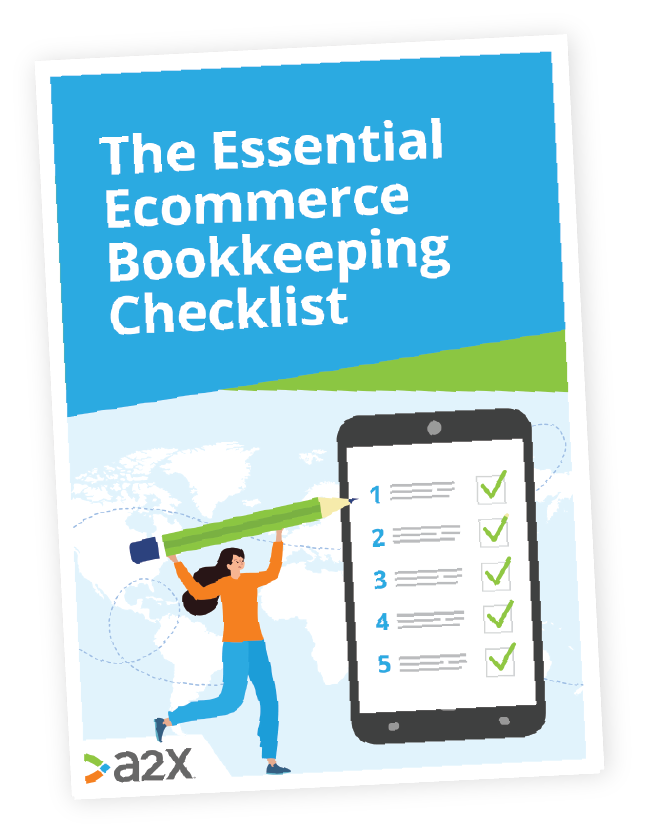
Effectively Managing Payroll for Your Ecommerce Business
It’s probably a pretty safe bet to say you didn’t start your ecommerce business to manage payroll. As much as it’s a not-so-glamorous task in the line of tasks you have on the go, it’s a necessary one once you start bringing employees into the fold of your ever-growing business. And one you’ll want to complete with precision.
As you probably know, payroll isn’t just about paying your employees and washing your hands of it. There are calculations, taxes, reporting, and other nuances that might feel a bit overwhelming when you initially think about them.
Although there’s a lot of stuff to know for payroll, it doesn’t have to be complicated. So, let’s take a look at uncomplicating and managing payroll for ecommerce businesses.
Table of Contents
Want to feel completely confident in your ecommerce bookkeeping?
Businesses that document their processes grow faster and make more profit. Download our free checklist to get all of the essential ecommerce bookkeeping processes you need every week, month, quarter, and year.
Download it here
Managing payroll: A brief breakdown
On the surface level, payroll is how much your employees get paid for the work they’ve completed during their scheduled work hours. But there’s a lot that happens between the work being done and pay day, such as:
- Collecting, organizing and keeping up-to-date employee data
- Calculating employee earnings
- This can look like multiplying the number of hours worked by their wage or dividing a yearly salary to determine how much of that is paid in a pay period.
- There are also other factors that go into employee earnings, such as commissions, tips, and bonuses.
- Calculating, withholding and reporting employer and employee taxes based on federal and provincial or territorial regulations
- Accurate record-keeping and reporting
- Being mindful of a variety of deadlines
- Examples of this are payroll processing and payment deadlines (think bank holidays impacting pay dates, for instance) and government remittance deadlines.
At its core, payroll is ultimately about accuracy and timeliness—and that’s where the crux of payroll management comes in.
What you’ll need to set up and manage payroll for your ecommerce business
The road to accuracy and timeliness in managing payroll for ecommerce businesses begins with setting it up, which then flows pretty seamlessly into managing it. Luckily, there are no special requirements for this business type in Canada. Payroll is still payroll.
With that in mind, you’ll want to:
- Register your business and set up a payroll program account.
- Familiarize yourself with federal and provincial or territorial laws.
- Decide whether you’ll have employees, contractors or both.
- Decide whether your employees are paid hourly or salary.
- Choose a pay frequency or schedule.
- Choose how you’ll pay your employees.
- Collect employee payroll forms.
- Collect and remit payroll taxes.
- Generate, distribute and file year-end tax forms for your business and employees.
Register your business and set up a payroll program account
Registering your business with the federal and provincial governments gives them a way to identify your business for filing, payment and reporting purposes. This may be a step you’ve already completed, but, if not, start here.
When you do, you’ll receive a nine-digit business number. Then the next step is registering for a payroll program account, which tells the government that you’re ready to pay employees, and the account will be used for remittance payments and reporting.
Similar to when you registered your business, you’ll get a payroll account number, which just uses your business number, plus two letters (RP) and then a four-digit reference number (typically 0001).
There are other agencies you’ll want to keep on your radar as well if they apply to your business (for instance, Workers Compensation Boards).
Familiarize yourself with federal and provincial or territorial laws
A big step in setting up and then managing payroll for ecommerce businesses (or any business!) is keeping up with governmental laws and regulations, including payroll tax regulations and labour laws. These laws can vary depending on where you live and can change.
Payroll tax regulations dictate calculations for both employer and employee portions of the taxes you’ll withhold from each pay cheque, as well as remittances for those taxes and so forth.
Labour laws set standards like how many hours employees are allowed to work, overtime pay, minimum wage, pay frequency, statutory holiday and vacation entitlement and more.
Making sure you stay compliant with laws in both these spaces keeps everyone happy. Happy employees and happy governments means no trouble for you as a business owner.
Decide whether you’ll have employees, contractors or both
While employees and contractors are similar in that they both complete work for your business, the way they do that isn’t quite the same.
Employees work directly for you, and you set things like their wage and work hours, while also handling payroll taxes and so forth.
Contractors might be hired to complete a project for your business, but they determine their work hours and rate of pay, while handling their own taxes.
Whether you have employees, contractors or both may change over time. It’s whatever’s best for your business!
Decide whether your employees will be paid hourly or salary.
This one is up to you. While there are those laws around minimum wage and overtime pay, whether you choose to pay by the hour or give your employees a yearly salary is your call. As long as it meets the other legislative requirements, you’ll be good to go.
Choose a pay frequency or schedule
How often you pay your employees can be referred to as a pay frequency or pay schedule. Different provinces and territories have different laws around how often you’ll need to pay your employees, so be sure to look into that.
Generally, there are four pay frequencies.
- Weekly: Employee gets paid every week.
- Bi-weekly: Employee gets paid every other week.
- Semi-monthly: Employee gets paid twice a month.
- Monthly: Employee gets paid once a month.
Apart from government regulations, you’ll also want to consider cash flow. Paying employees weekly might sound like a nice idea, but do you have the funds available each week to do that? Would something like bi-weekly or semi-monthly work better instead?
Choose how you’ll pay your employees
Are you going to pay your employees by cheque or direct deposit? While direct deposit is super common in today’s world and may seem like a no-brainer, you’ll still want to consider this when setting up payroll for your ecommerce business. If you choose direct deposit, for instance, you’ll need to get a void cheque or direct deposit slip from your employees to ensure you have accurate information when setting that up.
Collect employee payroll forms
Speaking of collecting information from your employees, make sure you collect their TD1 Personal Tax Credits Return forms so you can accurately calculate their taxes. There’s both a federal and provincial/territorial form you’ll need to send to them to fill out when they’re hired and at the beginning of each calendar year. Once you get it back, you can accurately deduct income taxes from their pay cheques.
This form also includes an employee SIN, which you can keep in your employee records for other employee forms you may need to generate, such as Records of Employment or year-end tax forms.
Collect and remit payroll taxes
Once you know the federal and provincial/territorial tax regulations and have your employees’ TD1 forms, you can start calculating and collecting payroll taxes each pay run. You’ll also need to remit them based on the remittance frequency assigned to you by the Canada Revenue Agency (CRA)—this is a key part of payroll management.
The tools you use to calculate the payroll taxes is up to you, but here are some considerations:
- Spreadsheet: While potentially cost-effective, if you’re using a spreadsheet with formulas, there’s a lot of risk for error. This can be costly and it also takes up a lot of time.
- CRA Payroll Deductions Online Calculation (PDOC): This will ensure accuracy and up-to-date formulas for calculating taxes, but requires some manual effort of inputting numbers.
- Payroll software: Payroll software can integrate up-to-date formulas straight from the CRA into the program. This reduces your workload and keeps things super accurate during the setup and management stages of payroll. Win-win!
Generate, distribute and file year-end forms for your business and employees
Better known as tax season, there are a variety of forms for payroll year-end just like you’d have for other year-end forms for your business. On the employee side, it means generating and issuing forms like T4 Statement of Remuneration Paid slips, and on the business side, you’ll have T4 Summaries. In Québec, that’d look like Relevé 1 slips and Relevé 1 Summaries.
Remember, you’ll want to keep an eye on government deadlines and requirements when it comes to filing these documents to avoid penalties!
Tips for managing your ecommerce business payroll
As you can see, we weren’t kidding when we said there’s a step or two to managing payroll for ecommerce businesses or otherwise. The good news is there are things you can do to keep things as seamless and easy as possible.
Keep organized, up-to-date employee records
Having up-to-date and organized employee records helps to avoid payroll and remittance mistakes that’ll need correcting later. You’ll also avoid any awkward conversations with the employee about how their deductions have been incorrect since it’ll have impacted them (and their taxes!) as well.
Appoint a payroll manager
When you have the capacity, appointing someone to manage payroll processing is a helpful way to make sure there aren’t any hiccups in data entry and to maintain consistency. This can even start as a hybrid or part-time role.
Keep an eye on your payroll reports
Regularly checking in with your payroll reports is another great tactic during payroll management to make sure there aren’t any errors that slipped by. The earlier you catch errors, the better. Not to mention that keeping an eye on your reports helps you keep on top of business finances as well.
Consider payroll software options
As someone in the ecommerce business space, you’re no stranger to working with online tools and potentially even cloud software. Why not consider a payroll software, too?
Payroll software, such as Wagepoint, helps make payroll processing simpler because it takes the heavy lifting out of things like tax calculations. Software can also facilitate remittance filing, employee form distribution, direct deposit pay, reporting and keeping payroll to a few-step process that’s done in a snap.
Not to mention minimal stress and the confidence that your pay runs are compliant and everyone is paid on time.
Payroll management begins
Hopefully this has given you some direction and places to start with setting up and what comes after with managing payroll for ecommerce businesses. From setting up your payroll program account to paying your employees, you should be well on your way to tackling payroll like a pro.
Want to feel completely confident in your ecommerce bookkeeping?
Businesses that document their processes grow faster and make more profit. Download our free checklist to get all of the essential ecommerce bookkeeping processes you need every week, month, quarter, and year.
Download it here
